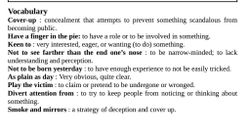May 29, 2023
Speak like a native review lesson No# 28,29,30/💯
Lesson 28
The Art of Deception: Unveiling the Smoke and Mirrors
Deception has long been employed as a strategic tool by individuals and institutions alike. From political scandals to corporate cover-ups, the art of deception is as old as humanity itself. Let's delve into this intriguing [in-tri-gu-ing] world where things are not always as plain as day.
One of the fundamental techniques of deception is the cover-up. By concealing the truth or manipulating information, individuals can paint a different picture, masking their true intentions. Those who have a finger in the pie are often keen to employ this tactic, leveraging [le-ver-ag-ing] their influence to shape narratives in their favor.
In the realm of deception, many choose to not see farther than the end of their nose. This short-sightedness allows them to ignore the broader consequences of their actions, focusing solely on immediate gains. However, one should not underestimate the audience's intelligence; people are not born yesterday. They can often detect the subtle signs of deception and recognize when someone is playing the victim to divert attention from their true motives.
To master the art of deception, one must be adept at creating smoke and mirrors. By employing intricate strategies and tactics, individuals can manipulate perceptions and create illusions. This diversionary [di-ver-sio-nar-y] technique seeks to shift attention away from the truth, keeping audiences enthralled in a web of deceit.
While the art of deception can be captivating, it is essential to remain vigilant and skeptical. By questioning the information presented and examining the motives behind it, one can unveil the truth hidden beneath the smoke and mirrors.
In conclusion, the art of deception is a multifaceted [mul-ti-fa-cet-ed] endeavor, often used to manipulate perceptions and gain an upper hand. Employing cover-ups, playing the victim, and using smoke and mirrors are just a few techniques employed by those keen to deceive. However, it is crucial not to let oneself be blinded by these tactics, always striving to see beyond the illusions and uncover the truth that lies beneath.



Lesson29
Being Environmentally Responsible: It's Not the End of the World
We often hear about the dire consequences of environmental degradation, but being environmentally responsible is not the end of the world. In fact, it's a collective effort in which we are all in the same boat. Taking small steps towards sustainability [sus-tain-a-bil-i-ty] can make a significant difference and deserve a pat on the back.
One might think that individual actions have little impact, but every small effort can go a long way. Each person who decides to be a go-getter and actively participate in protecting the environment is contributing to a greater cause. It's about taking responsibility and understanding that our actions matter.
To be environmentally responsible, we need to get out of our comfort zones and explore sustainable alternatives. It's about beating the conventional norms and seeking innovative solutions. By embracing renewable [re-new-a-ble] energy, reducing waste, and conserving resources, we can create a positive impact on the planet.
However, it's important to be cautious and not be taken for a ride by greenwashing [green-wash-ing] or misleading claims. Some companies might market their products as eco-friendly without substantial evidence. To make informed choices, we must dig deeper and scrutinize [scru-ti-nize] the sustainability claims before supporting a brand.
In conclusion, being environmentally responsible is not a daunting task. It's about realizing that our actions, no matter how small, can make a significant difference. We are all in the same boat when it comes to safeguarding our planet. So let's give ourselves a pat on the back and be the go-getters who lead the way towards a greener future



Lesson 30
Building Discipline for Training: The Path to Success
Discipline is the key to achieving success in any endeavor, be it physical fitness, skill development, or personal growth. Without discipline, our efforts can easily fall apart, leaving us frustrated and demotivated. If you're tired of starting strong but quickly losing steam, it's time to embrace discipline and make it an integral part of your training journey.
Firstly, it's crucial to let go of the temptation to go nuts and expect overnight transformations. Building discipline is a gradual process that requires consistent effort and patience. Instead, focus on small, achievable goals that you can consistently work towards. Keeping your word to yourself and committing to these goals is a vital step in building discipline. When you make a promise to yourself, it becomes easier to stay on track and avoid going back on your word.
Discipline is like a sturdy structure that holds everything together. Without it, our efforts can easily fall apart, just like a fragile construction. By cultivating discipline, you strengthen your commitment to your training regimen, ensuring that even when faced with challenges, you stay steadfast and determined.
Letting on is another aspect to consider. It's important to surround yourself with a supportive network of like-minded individuals who share your goals and values. Their encouragement and accountability can help you stay on track and keep you motivated during tough times. Knowing you can count on them for support makes the journey more manageable.
Remember, building discipline is no bed of roses. It requires sacrifice, perseverance, and a strong will to overcome obstacles. There will be moments when you question your choices, but looking back at your progress and how far you've come will reignite your motivation. Reflecting on your journey can reinforce your commitment and help you stay focused on your ultimate goals.
Discipline is often associated with strictness and self-deprivation, but it's essential to find a balance that works for you. Incorporate activities and techniques that bring you joy and make the process enjoyable. Embrace the journey as a heavenly experience, where every step brings you closer to your desired outcomes.
In conclusion, building discipline for training is a transformative process that requires dedication, perseverance, and a strong sense of commitment. By keeping your word, surrounding yourself with supportive individuals, and reflecting on your progress, you can cultivate discipline and pave your way to success. Remember, it won't be a dog's life, but a rewarding and fulfilling journey that will empower you to achieve your goals.



By undefined
12 notes ・ 9 views
English
Advanced